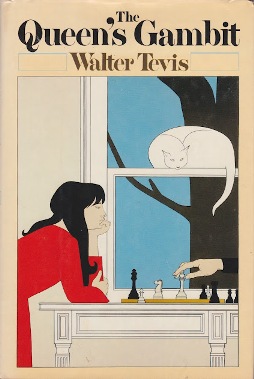
I watched the Queen’s Gambit on Netflix a month or so ago and found it quite entertaining. I looked to see the story’s origin and found that it is a work of fiction from the same author that wrote The Hustler many years earlier. The Hustler became a 1961 movie starring Paul Newman as pool shark ‘Fast Eddie’ Felson. A character that was continued in 1986 film, The Color of Money with Newman and Tom Cruise. According to his Wikipedia page, Tevis taught English literature and creative writing at Ohio University in Athens, Ohio from 1965 to 1978, where he was named University Professor. Tevis passed away in 1984 of lung cancer.
The book’s main character, Beth, resides in Kentucky and starts in the early 1950’s. I have read many books that were later turned into feature-length films and have grown accustomed to movies leaving out many scenes that are present in the original printed story. This is the first book I have read that was turned into a mini-series. Just about everything in the book is in the Netflix mini-series. The only significant omissions are from the very beginning of the book. At a very young age, both of Beth’s parents are killed in an automobile crash in the beginning of the book and it appears to be accidental. In the Netflix series, just Beth’s mother dies from what appears as vehicular suicide. Her father, in the series, wants no part of raising her. In both versions, Beth ends up being raised in a Kentucky orphanage from an early age.
Another omission in the Netflix series is the relationship between Beth and Jolene – another older orphan. They have a sexual encounter in the book that is not present in the Netflix mini-series. I can forgive this omission. It did not add much to the story, and putting a sex scene with two very young girls on video would probably not be a good business decision.
The orphanage initially gives daily sedative pills to the girls to keep them well-mannered. Beth builds an addiction to them as a child and struggles with this and alcohol addiction throughout the novel. Very early in her stay at the orphanage, she notices that the custodian, Mr. Schaibel, plays a peculiar game in the basement during his free time. This game turns out to be chess and Beth is strangely drawn to it. She convinces a reluctant Mr. Schaibel to teach her this game, which she quickly becomes extremely proficient at. She has an incredible ability to visualize and play out games completely in her head. She ‘sees’ the moving pieces above her as she lies in bed every night. Her skill does not go unnoticed by Mr. Schaibel. Mr. Schaibel is a pretty decent amateur player and young Beth learns to best him in a fairly short time. Still in grade school, she is able to easily best all of the local high school chess club members simultaneously.
Then her addiction to the sedatives gets the better of her. The orphanage no longer gives out the pills and she goes into withdrawal. In an effort to quell her cravings, she attempts to steal some sedatives, is caught, and receives the worst imaginable punishment for her – no more chess. For three years she is not allowed to physically play chess, but she still studies a chess book given to her by Mr. Schaibel – Modern Chess Openings. At night she still visualizes the board and pieces moving around on the ceiling above her bed.
She is then adopted by a couple, Alma and Allston Wheatley, when she is 13 years old. I say couple because a husband and wife adopt her, but the husband, Allston, is a traveling salesman who is never home and seems to have no interest in Beth or Alma. Beth seems to be acquired to give Alma an acquaintance to keep her off of Allston’s back. The book paints Alma much like Netfilx does. She is a heavy-smoking, somewhat alcoholic, motivation-less housewife with zero ambition and a love of television. In the book, however, she appears much more overweight and out of shape.
Outside the orphanage Beth learns that, if someone is good enough, he can actually make a good living playing chess. I say ‘he’ because chess is completely male-dominated at the highest levels, particularly in the timeframe of this story. Contrary to the lackadaisical Alma, Beth is highly motivated to excel. She is driven to play and compete. Alma has zero interest in Beth’s desire’s to play chess and Allston appears to have dropped out of the picture completely – leaving Beth and Alma without much income. Beth needs five dollars to compete in a local tournament. She has to write Mr. Schaibel to obtain this paltry sum. She wins the tournament, and with it, a decent sum of money and local notoriety. This event puts some motivation into Alma who sees the golden goose in Beth, in front of her. They travel the country and fund their existence with Beth’s tournament winnings.
Eventually Beth makes it to tournaments outside of the US and becomes a fairly well-known player. At a tournament in Mexico, Alma dies in her sleep after not feeling well for a few days. Beth, still a minor, has to fend for herself. Allston does not return, but tells Beth over the phone that she can have the house. She continues the routine of traveling and competing to fund her life. Along the way she makes friends with other players, adds to her notoriety, and struggles with her addictions. Two of her friends, Benny, and Bektik become love interests for short periods with romances largely taking a back seat to a passion for excelling at chess.
She is becoming a world-class player, but also a world-class addict. She recognizes her problem and manages to re-connect with Jolene, who is now a graduate student and fitness fanatic. Jolene manages to whip Beth into shape and steer her from her self-destructive ways.
At the end of the novel Beth is playing in Russia against the fictitious world champion Vasily Borgov. She recognizes that the great Russians rely on each other for help in tournaments and she is given help by her friends back home at a critical moment before she is to finish her match with Borgov. In the end she defeats Borgov and is able to thank everyone that helped her on her journey.

